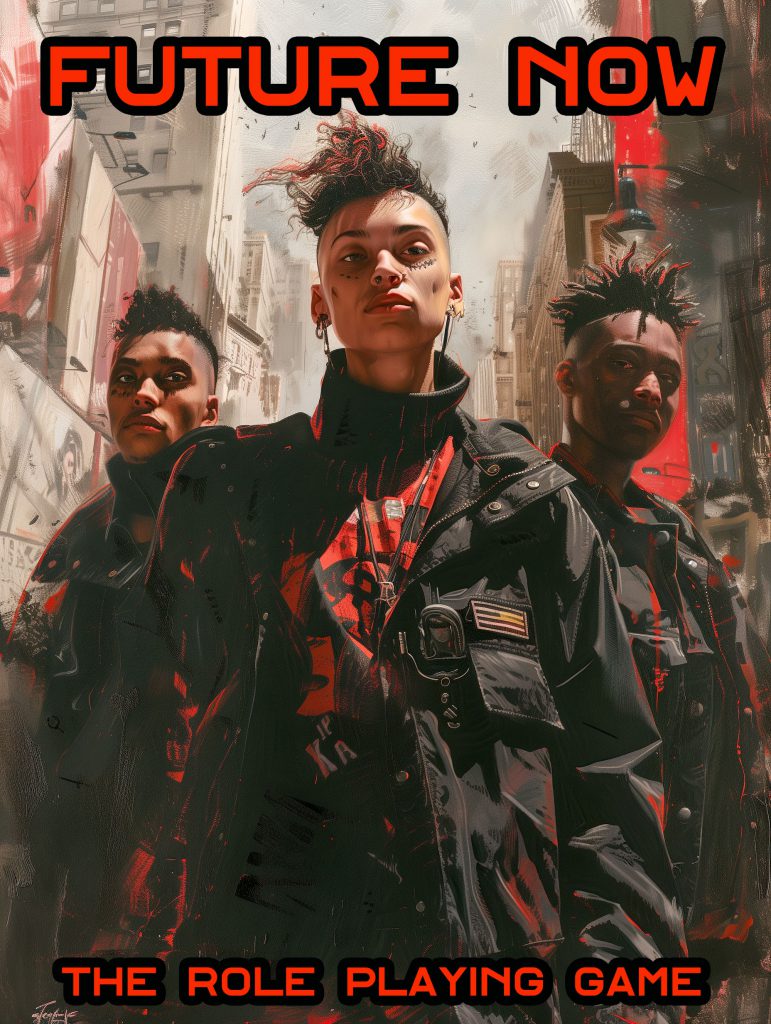This is the last in a series of write-ups of games and game settings that we wanted to make, but that (most likely) will never be made. If you’re reading this and have a strong desire to help one of these dead game ideas become reality, email creative [aht] vajraenterprises [dot] com.
P.S. We don’t use AI generated art in our games, but we have just for the Vajra Game Graveyard series. You can read more about our position on AI generated art here.

Setting Concept
A game set in the same universe of Fates Worse Than Death, but before both Fates Worse Than Death and Seconds to Midnight. It is a near future that, at first glance, looks very much like our own time, but this is only because the technologies that might radically change human lives have been patented, monopolized, regulated, turned into ‘trade secrets” and used solely for the benefit of governments and corporations. The United States (like most other nations) is quietly becoming an authoritarian surveillance state, where technology is used to monitor the population and suppress dissent, while most of the population are oblivious. Use of new technology in any way that threatens those in power has been made illegal and driven underground. New York City will be presented as the default setting.
Heroes
“Futurists” who are using illegal technology in an attempt to wrest control of the future from those in power. Not only are they fighting back against the repressive government, they are actively seeking new and better ways to live, despite the risk of imprisonment. These characters experiment with better ways to interact with technology, with media, with culture, with urban spaces, with their own bodies and their own brains.
Antagonists
Riot cops, feds, corporate security teams, robotic security drones, gangs of citizen bounty-hunters that are after the reward for capturing and turning in a supposed “terrorist,” secret agents from countries who have already gone much farther down the totalitarian rabbit hole.
Themes
That new technology has the power to either hurt or harm depending on how it is used. How the people who benefit from a new technology (rather than being harmed by it) are those who control it. The duty of new generations to experiment with new ways of being and find out what works for them, even if that puts them at odds with the established powers of society. That many technological advances came about when home hobbyists were able to tinker with new technologies, contributing greatly to the history of technology. The idea that the possibilities for the future imagined in science fiction might already be here, even if most of the population is unaware of it.
Aesthetics
Rather than the run-down half-abandoned New York of Fates Worse Than Death, this would be a gentrified New York with signs everywhere of “law and order.” Propaganda posters and surveillance cameras will be common. High technology will be visible, but always being used against rather than for citizens (e.g. barriers that pop up out of the street for traffic stops, surveillance drones scanning people, security guards with personal helicopters). Tall corporate and government buildings seem futuristic but at street level things look very much the same as today.
Mechanics
Running from cops, feds and corporate security agents will probably be a big part of gameplay. The Chase rules from In Dark Alleys can be adapted to this setting, with parkour skills available to help PCs on the run from cops. Since hacking (in its broader sense of making technology do new things) is a big element here, there should be some rules for inventing and upgrading technology, perhaps borrowing from the invention rules from Price of Power.
Research Needed
Techniques of surveillance, social control and suppression of dissent and protest used by governments in modern times, and especially how new technology is used against dissenters.
Challenges
Such a depiction of an almost-now future can’t help but be political, and will anger those who don’t see their views reflected there. It will be interesting to see to what degree we can pull in elements of the futures feared by people of various political ideologies, but without betraying the beliefs of the authors.
